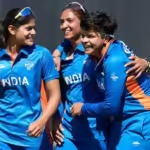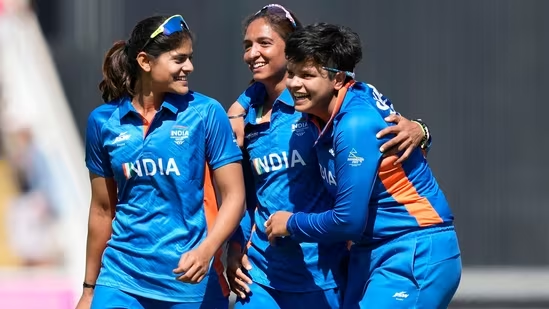From being cheerleaders to being cheered on by 1.2 billion people – here’s the incredible journey of Indian women’s cricket.
Year, 2005. The Australian women bat first and put up a competitive 215/4 score on the board thanks to a brilliant century from Karen Rolton. You would think that the chasing team has the upper hand – but, no. Not against that Australian team. India gets bundled out for a meagre 117, 23-year-old Mithali Raj and Jhulan Goswami get a harsh lesson.
Fast forward to 2017. England are playing the World Cup final on their home turf, Lord’s. 35-year-old Jhulan Goswami bowls a magnificent spell of 3/23 to restrict England to 228/7. India gets the chase off to a fantastic start, looks like cruising to victory. 191/3 – India need
38 runs of 7 overs to win a historic maiden Women’s World Cup title. What followed was 30 minutes of madness. From 191/3 to 219/10, India collapsed like a pack of cards in no time.
Heartbreak. Once again.
Two World Cup Final losses.
Two similar heart-breaking stories.
Two occasions when Mithali Raj and Jhulan Goswami saw their dreams shatter.
However, in 2017, something changed.
And, looking back at it now, it definitely changed for the better.
The turning point of Indian women’s cricket.
Chapter 1: The BCCI Takeover
The beginning of the change in Indian women’s cricket was marked by the takeover of the women’s national team by the Board of Control for Cricket in India (BCCI) from its predecessor Women’s Cricket Association of India (WCAI) in 2006. The women cricketers were given central contracts and inducted into the National Cricket Academy (NCA). The change was evidently visible as the women’s team played a higher number of matches in the next decade (2006-2016) than the past 30 years (1975-2005) under the WCAI as indicated in the table below.
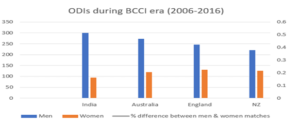
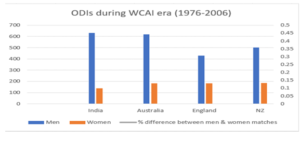
Chapter 2: Two World Cup Finals in 4 years
Results bring rewards, achievements bring applause. Indian women’s cricket was on the rise since BCCI took over, but where were the results that would draw the crowd to stadiums and viewers in front of their Television sets? The cricketing revolution in India has happened twice in the men’s game – the 1983 World Cup win which changed Indian cricket forever and the 2007 T20 WC win which led to the introduction of the Indian Premier League, taking cricket to the next level. However, the women had nothing to show, barring the one-off appearance in the 2005 World Cup final. So, what would fuel the revolution in the women’s game?
The summer of 2019 – it was high time that the women’s cricket team stepped up. The girls chose the perfect stage to capture the attention of fans back home and worldwide – the ICC Women’s World Cup in England. India started their campaign with an incredible win over the hosts England in their opening match and didn’t stop until they caused the huge upset of getting the better of reigning champions Australia in the semi-finals. Harmanpreet Kaur’s amazing knock of 175* and India’s tremendous bowling performance caused a frenzy back home as India stormed through to the final.
The stage was set – a perfect opportunity for India to lift the sport’s Ultimate prize at the home of Cricket, Lord’s. India were in cruise control until the 42nd over of the 2nd innings but as fate would have it, England clinched victory from the jaws of defeat to leave the Indian players in tears. An unfortunate ending for sure, but it marked the beginning of a new era in Indian women’s cricket.
The final between England and India recorded a peak concurrency of 1.9 million simultaneous viewers on India’s leading OTT platform Hotstar. Just to put things into perspective, the last time India Women reached the final of a World Cup (2005) no private Television body even bought the rights to telecast the game!
The surge in viewership reached the greatest of heights in the 2020 Women’s World Cup. An incredible 156 million people viewed the event in India, of which 80 million was rural reach and 126 million were for the final alone. India’s fine performances which saw them reach the final in Australia, contributed to a 500% increase in viewing hours in the country. If we compare it with other countries, India witnessed a greater increase in viewing percentage than powerhouses like the United Kingdom (300%) and Australia (131%). South Africa topped the list with a whopping 861% increase in viewership.
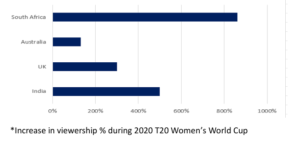
Chapter 3: Women’s cricket captures the imagination of 1.2 billion Indians
After the 2017 World Cup, women’s cricket had captured the imagination of the cricket loving fans in India. However, the love and fan following needed a catalyst to take it to the next level. In 2018, the Women’s T20 Challenge (WTC) was launched with national and international players sharing the dressing room together – a first of its kind in Indian women’s cricket. After two decent seasons, the tournament got a major breakthrough when the 2020 edition of the WTC witnessed a massive increase in viewership. The 2020 edition recorded 5.34 billion minutes in viewership in India. It was a 2.45-times increase from the 2.20 billion minutes THAT the 2019 edition recorded, with as many as 105 million unique viewers tuning into the three-team competition as opposed to 71 million viewers in 2019.
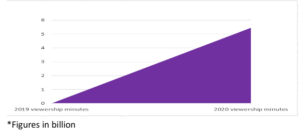

By the end of 2020, Indian women’s cricket had become a force to reckon with. It was high time that the cricketers got rewarded for their performances on the field and more importantly, for playing a pivotal role in popularising the women’s sport in India. On October 27, 2022, BCCI finally gave the cricketers their due credit and announced the landmark decision of ‘equal pay’ for both men and women cricketers. The women’s national team cricketers currently get the same match fees as their male counterparts – Rs 15 lakh for Tests, Rs 6 lakh for ODIs and Rs 3 lakh for T20 international matches.
Women’s cricket was now a profit-making entity in India and how can the glamour of the business and Bollywood world stay away from it? The inaugural edition of the Women’s Indian Premier League (WIPL) was hosted earlier this year – another major milestone in Indian women’s cricket.
The WIPL has been an instant success with a record-breaking 10 million viewers tuning in for the final between Mumbai Indians and Delhi Capitals in 2023. It is, incidentally, the highest viewership on any women’s cricket event globally. The TV rating for the first week of the WIPL was 0.22, which went up to 0.28 in the second week, and then fell down slightly to 0.27 in the third.

Besides logging record Viewership on television and streaming platforms, most WIPL matches were also sold out when it comes to stadium attendance. The final was attended by the maximum capacity of 35,000 at the Brabourne while the play-off was attended by 25,000 people.
From being cheerleaders to being cheered on by 1.2 billion people – Indian women’s cricket is an extraordinary success story. The women have hit sexism and stereotypes out of the park and yes – they are here to stay!




